A simple barbell in a squat rack may not seem like a piece of modern-day technology, but it kinda is. Up until a few decades ago, lifters were either making their own racks by hand from scrap metal and wood, or they were figuring out how to get the bar lifted by any means necessary.
One popular method was created by Ed Zercher, a St. Louis-based weightlifter from the 1930s. Rather than get the bar onto his back, he developed a technique to get the bar from the floor into the crook of his arms so he could squat while clutching the weight to his torso.
This type of squat was dubbed “the Zercher squat.” Even if you’re a full-fledged 21st-century lifter, you can benefit from this old-school exercise.
- How to Do the Zercher Squat
- Zercher Squat Mistakes to Avoid
- Benefits of the Zercher Squat
- Muscles Worked by the Zercher Squat
- Who Should Do the Zercher Squat
- How to Program the Zercher Squat
- Zercher Squat Variations
- Zercher Squat Alternatives
- Frequently Asked Questions
How to Do the Zercher Squat
While the Zercher squat was originally intended as a solution for lifters without a squat rack, this approach does require the bar to begin either in a rack or set on benches, blockers, or another elevated surface. A Zercher movement for the rack-less lifter will be explained later in the Variations section.
Step 1 — Unrack the Bar
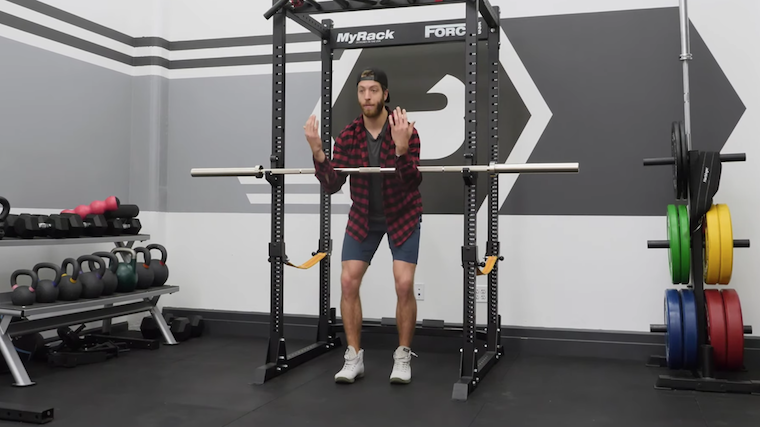
Set a barbell between your belly button and your chest, either in a rack or supported on benches, steps, or blocks. Stand as close as possible, with your feet directly under the bar at shoulder-width. Keep your shoulders back. Squat down just low enough to get your elbows under the bar.
Cradle the bar in your elbows, between your forearms and biceps, and curl both hands as close to your shoulders as possible. The palms of your hands should be pointed towards your face and your elbows should be tight to your ribs. Lift the weight by standing up. Lock your legs and stabilize your entire body. Take one full step backwards. Step one foot sideways to set your stance outside of shoulder-width.
Form Tip: For many lifters, physical discomfort from holding the bar in position is the biggest challenge. Wrapping the bar in a towel or bar pad (often meant to cushion the neck during back squats) is a solution as your body adapts to the pressure. Keeping your hands palms-up, not thumbs-up, will also help to disperse stress onto the muscles of the forearm instead of the bones of the forearm.
Step 2 — Squat Down
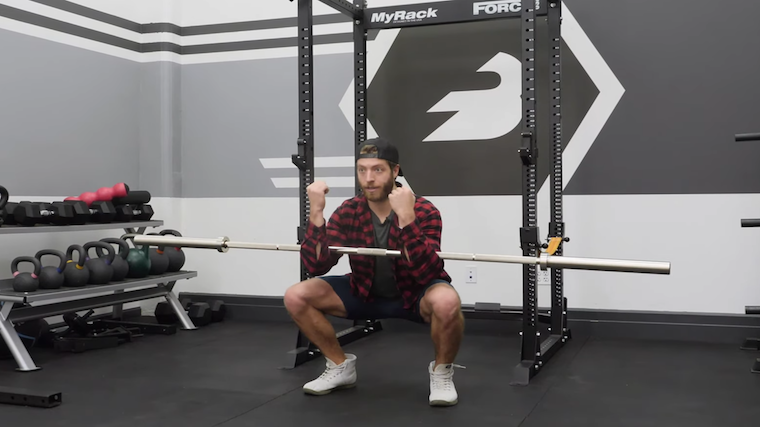
Maintain a stable and wide stance, beyond shoulder-width. Take a breath into your belly and tense your abs. Shift your hips backwards to squat down until your elbows or the barbell (depending on arm length) barely touch your thighs. Keep your torso as upright as possible throughout the movement.
Don’t allow the weight to pull your elbows forward or your arms to straighten. Your hands should remain near your shoulders or your chin during the movement. Pause very briefly in the bottom position.
Form Tip: Maintain full-body tension in the bottom position. Don’t relax your legs, core, or arms. Don’t allow the weight to “unload” onto your legs, which decreases muscular tension and increases overall joint strain.
Step 3 — Stand Up to Lockout
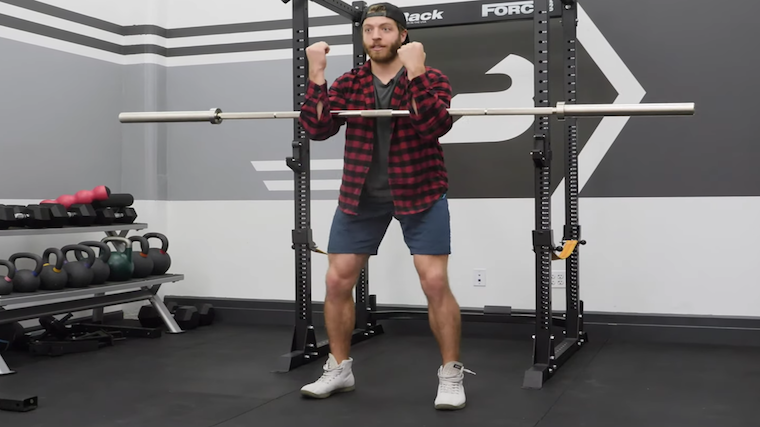
From the bottom position, keep your feet flat while pressing upwards to a standing position. Keep your shoulders back and squeeze your elbows into your sides to encourage upper body tension. As your legs lockout, squeeze your glutes to increase tension and ensure a strong standing position.
Form Tip: Pause very briefly in the locked out position to ensure total-body tightness. Don’t rise explosively to prevent the bar from bouncing in your arms; move with steady power and control.
Zercher Squat Mistakes to Avoid
Because the Zercher squat involves a unique and often unfamiliar bar position, there are several common mistakes many lifters may make which can reduce effectiveness and increase the risk of injury.
Leaning Forward
Much like the front squat, the Zercher squat supports the barbell in front of the body. This requires an upright torso position during the entire movement. Leaning forward shifts your center of gravity and pulls your upper body into a weakened position.
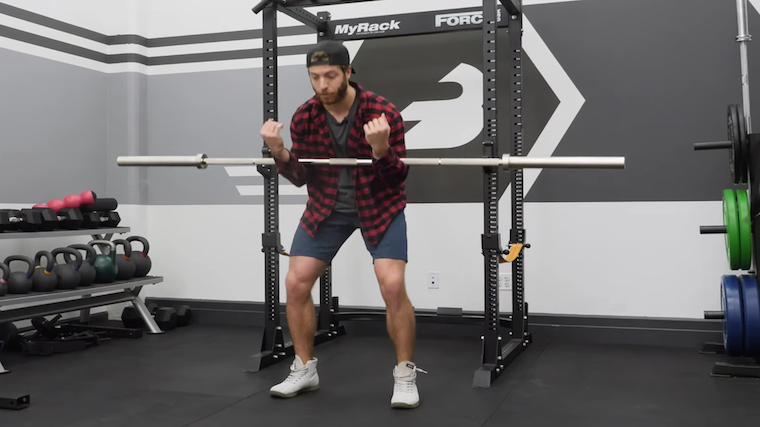
When the upper body falls forward, either the bar will roll out of your arms or you’ll manage to keep control of the weight while grinding out a rep with a serious leverage disadvantage, exposing your lower back to potential injury.
Avoid It: Maintain a vertical torso by keeping your shoulder blades pinched back and, even more importantly, by keeping the bar as close to your body as possible. Create tension through your arms, abs, shoulders, and back to hold the bar in position.
Short Range of Motion
The lower one descends into a squat position, the more glute and hamstring muscles are recruited. (1) Squatting to a relatively higher position may offer specific benefits, such as competitive powerlifters who only need to reach a parallel-thigh position and not any lower.
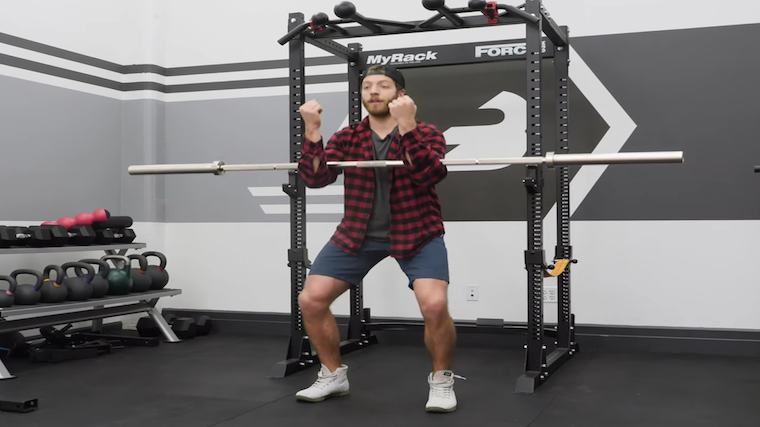
However, when a lifter unknowingly squats high or deliberately squats high as an “easier” option, they shortchange their overall results. Partial rep squatting can also increase stress on the knee and hip joints compared to squatting to lower depths. (2)
Avoid it: Because the bar is held relatively low on the body during the Zercher squat, the barbell acts as a built-in boundary, offering an unwavering target for depth. Make sure the bar reaches your thighs at the bottom of each rep.
Bouncing Off Your Legs
Maintaining control of the weight during an exercise is essential for developing muscle and power. Uncontrolled, explosive movements also open the door for unexpected injuries.
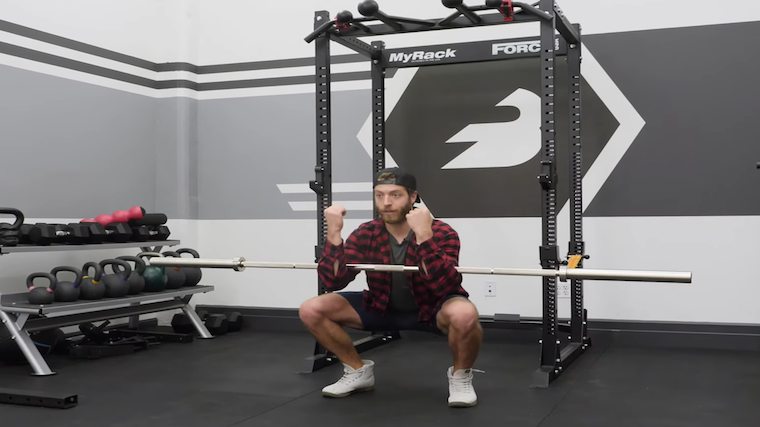
While a guideline for proper Zercher squat technique is to reach the bar to the tops of your legs, some lifters descend so quickly that the bar impacts their legs and rebounds upwards. Clearly, smashing your thighs with 100-plus pounds at a fairly high rate of speed isn’t the best idea.
Avoid it: Lower yourself under control, don’t free fall. Imagine your phone resting on your legs and touch the bar as softly as possible without breaking it.
Benefits of the Zercher Squat
The Zercher squat is more taxing, and slightly more complicated, than other squat variations. That extra effort can pay dividends with increased muscle recruitment and more overall strength gains.
View this post on Instagram
Leg Strength
The Zercher squat allows the legs to move significantly heavy weight with a stable and engaged core, reducing potential lower back strain (compared to other squat variations). Power output is optimized due to overall leverage, making the legs the primary mover and the most significantly recruited muscle group.
Leg Size
The Zercher squat has been shown to activate the quadriceps comparable to several popular squat variations, while also activating the glutes and hamstrings to a higher degree. (3) This increased muscle activation can directly lead to more muscle growth.
Upper Back Strength
While the upper back isn’t worked through a significant range of motion, it is heavily activated to keep your shoulders back while maintaining a stable upper body position. This constant work, resisting the barbell’s forward and downward pull, leads to a stronger upper back.
Core Strength
The abs and lower back are essential for preventing your upper body from collapsing forward under the stress of the weight. Coordinating the abs and lower back in this type of supportive role is essential for building total core strength.
Sport-Specific Training
The front-loaded barbell position of the Zercher squat can offer direct carryover for strength athletes who compete in similar front-loaded events. In strongman/strongwoman contests, this would include atlas stones, stone carries, and, most specifically, the “Conan’s Wheel” event.
Training Around Lower Back Pain
All types of squats can help to build lower body strength, but many squat variations require intensive lower back stress which can be a limiting factor for some lifters. Due to the unique bar position and increased overall core recruitment, the Zercher squat doesn’t significantly strain the lower back, allowing lifters to target their legs with reduced back pain.
Muscles Worked by Zercher Squat
The Zercher squat is predominantly a lower body exercise, but it involves multiple large muscles in the upper body as well.
View this post on Instagram
Quadriceps
The quads are significantly recruited during any squat, particularly as you reach the bottom position of the Zercher squat. The quads are responsible for straightening the leg and extending the knee, which helps you rise from the bottom position and get to a standing position.
Glutes
The glute muscles play a key role to “extend” the hips and bring the legs directly under the upper body. Performing a complete lockout in the top position allows the glutes to maximally contract.
Hamstrings
The hamstrings consist of several different muscles heads, each of which coordinate to flex or bend the knee. The hamstrings are recruited and act as “brakes” while lowering yourself into the bottom of the squat position.
Upper Back
The upper back (consisting of the trapezius, rhomboids, rear deltoids, and other smaller muscles) is highly activated from the moment you unrack the barbell until the set is completed. The upper back works to keep your shoulder blades retracted (pinched together) and prevents your upper body from rounding forward into a dangerous position.
Spinal Erectors
The spinal erectors, or technically “erector spinae”, are more commonly referred to as the “lower back” although they’re a pair of muscles which run the entire length of the spine. They work primarily to prevent the rounding of the back and to maintain a straight upper body posture.
Abs
The abdominal muscles are responsible for more than just flexing or “crunching” the upper body. They control all basic movement from the hips up, including rotation, bending to either side, and to prevent bending backwards.
Biceps
The biceps, like the upper back, aren’t worked through any significant range of motion during a Zercher squat but they are highly activated to maintain a static position while holding the bar in place. It’s not uncommon for a lifter to feel muscular fatigue in their biceps after a set of hard Zercher squats.
Who Should Do the Zercher Squat
The Zercher squat can offer specific benefits for any lifter who can overcome or acclimate to the initial physical discomfort of the bar position.
Strength Athletes
Competitive strength athletes who perform front-loaded events can benefit directly from the Zercher squat. Athletes in any strength sport can benefit from the Zercher squat’s carryover to overall strength and core stability. Because of its significant upper back recruitment, it’s well-suited as an accessory exercise for either the squat or deadlift.
Training for Muscle
The Zercher squat isn’t a common exercise for muscle-building purposes, but it can serve as an effective squat variation to target the legs without excessive strain on the back.
How to Program the Zercher Squat
The Zercher squat can be programmed in line with multiple goals, but lower rep ranges are typically preferred to prevent fatigue as a limiting factor.
Heavy Weight, Low Repetition
The classic set and rep scheme of three to five sets of three to five reps is a reliable approach to build strength in any big lift, like the Zercher squat. The key to moving heavy weights is taking the time to adjust to the physical pressure at the elbows in the support position.
Moderate Weight, Low Repetition
Slightly reducing the weight while maintaining a lower rep range can shift the focus from leg strength to strength in the core and upper back. Two to four sets of four to six reps is an efficient way to train these total-body stabilizer muscles.
Zercher Squat Variations
Lifters may progressively work towards a full Zercher squat while adjusting to the bar position. Here are the most comparable options.
Goblet Squat
The goblet squat is a similar front-loaded squat variation, holding a dumbbell or kettlebell in the hands near chest-level. It offers reduced lower back stress, making it ideal for any lifter with back issues.
The goblet squat also allows for a complete range of motion, letting the lifter squat as deep as their hip and ankle mobility will allow. While the goblet squat is sometimes used by beginner lifters, it can be progressed heavily and can benefit even the most advanced lifter.
Sandbag Zercher Squat
Training with a sandbag offers countless benefits ranging from increased core stability to overall calorie-burning. It’s also an excellent callback to homemade training equipment, in the true spirit of Ed Zercher.
Using a sandbag instead of a barbell does compromise on potential load, since you don’t often find 300-pound sandbags, but the thicker diameter makes the support position extremely more comfortable, which allows you to focus on basic exercise technique and intensity.
Zercher Carry
The Zercher carry removes the squat portion and swaps it for a nice, long walk. Anytime you move while carrying a load, your core activation will light up. Zercher carries, in particular, will also involve your upper back (specifically the traps) to a very high degree.
A word of warning: Be sure to pay attention to your surroundings when Zercher carrying a barbell. You’ll be moving a wide load and the last thing you need is to have the seven-foot long barbell clip an object on one side and throw yourself into a spin.
Zercher Deadlift
The literal granddaddy of all Zercher lifts, the Zercher deadlift starts with the barbell on the floor rather than a rack, just the way Ed did them.
Sometimes called a “full cycle Zercher,” this movement is a multi-step process requiring you to deadlift the weight, hold the bar in position while squatting your body down, rest the bar on your legs, take the bar into the crooks of your arms, and then squat up.
This drawn-out technique involves so many moving parts, literally, that many lifters may not find it efficient for their goals. It is, however, a purebred piece of weightlifting history and is worth an experience, if only with an empty barbell.
Zercher Squat Alternatives
Not all lifters may need to incorporate the Zercher squat into their routine. There are several exercises which can offer similar benefits.
Front Squat
The front squat may appear to be a “Zercher squat while holding the bar higher on your body.” That’s a fair assessment. By using a “rack position,” the front squat keeps the weight in front of the body, supported across the front of the shoulders.
This allows the legs to be trained with drastically reduced lower back stress. The wrist and shoulder mobility needed to achieve a strong rack position can be relatively quickly trained with minimal direct attention.
High-Bar Squat
A simple variation of the basic back squat, placing the bar high on the shoulders and traps allows the lifter to maintain a more vertical torso, which reduces lower back strain.
This squat variation also offers much more direct carryover to competitive powerlifters, compared to the Zercher squat, because the bar is placed nearly identical to their contest lift. (Though, many competitive powerlifters opt to use a low-bar squat position, which places the bar more on the middle traps.)
Safety Bar Squat
The key benefit of the safety bar squat is the hand position, which accommodates lifters whose shoulder problems prevent holding a bar across their back.
A significant secondary benefit of the safety bar squat is increased upper back recruitment, due to the way the specialized handle offsets the barbell from your center of gravity. This upper back recruitment can offer comparable benefits to Zerchers.
FAQs
The bar hurts my arms. What’s the solution?
Probably the single most common issue with Zercher squats is the initial discomfort of holding the barbell in the elbow-supported position. There are a number of very effective workarounds that allow you to gradually adapt to the feeling while working on the exercise.
You can cushion yourself by wearing long-sleeve shirts and/or elbow sleeves (some lifters wear knee sleeves on their arms because the knee sleeves are larger and more comfortable). You can also cushion the bar with a bad pad typically used when the bar’s on your neck, or by wrapping a towel around the barbell.
Increasing the diameter of the bar also reduces the direct pressure. If your gym has thick barbells or axles, those work very well. Attaching removable thick-grip handles can also work.
Lastly, if you don’t feel that adapting to the movement is a good investment of your time in the gym, and presuming you’re not a competitive athlete performing Zercher-type movements in competition, it’s entirely acceptable to simply choose a different exercise.
Will the barbell crush the tendons in my elbows?
No, it won’t. Biceps tendon injuries at the elbow are relatively rare in the gym and, even then, they most often occur at the shoulder, not at the elbow. (4)(5)
While the biceps tendon does attach to the elbow joint, it’s not being strained in the Zercher position because it’s under a static contraction. Biceps tendon injuries typically occur when the tendon is “overstretched” with too much weight, too much speed, or too much range of motion. During a Zercher squat, the tendon isn’t put through any of those conditions.
However, if you have pre-existing elbow pain or inflammation issues, the exercise becomes a different scenario. In that case, as with any exercise, you should choose movements which do not aggravate your condition or affect recovery.
References
- Kubo, K., Ikebukuro, T., & Yata, H. (2019). Effects of squat training with different depths on lower limb muscle volumes. European journal of applied physiology, 119(9), 1933–1942. https://ift.tt/ie8jDrI
- Hartmann H, Wirth K, Klusemann M. Analysis of the load on the knee joint and vertebral column with changes in squatting depth and weight load. Sports Med. 2013 Oct;43(10):993-1008. doi: 10.1007/s40279-013-0073-6. PMID: 23821469.
- Erdağ, Deniz & Yavuz, Hasan. (2020). Evaluation of Muscle Activities During Different Squat Variations Using Electromyography Signals. 10.1007/978-3-030-35249-3_114.
- Golshani K, Cinque ME, O’Halloran P, Softness K, Keeling L, Macdonell JR. Upper extremity weightlifting injuries: Diagnosis and management. J Orthop. 2017;15(1):24-27. Published 2017 Nov 7. doi:10.1016/j.jor.2017.11.005
- Lavallee ME, Balam T. An overview of strength training injuries: acute and chronic. Curr Sports Med Rep. 2010 Sep-Oct;9(5):307-13. doi: 10.1249/JSR.0b013e3181f3ed6d. PMID: 20827099.
Featured Image: BarBend / Youtube
The post How to Do the Zercher Squat for Lower Body Size and Power appeared first on Breaking Muscle.
from Breaking Muscle https://ift.tt/axoRZS9
via IFTTT
Comments
Post a Comment